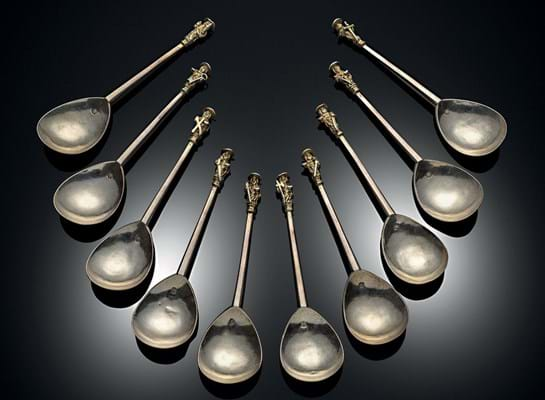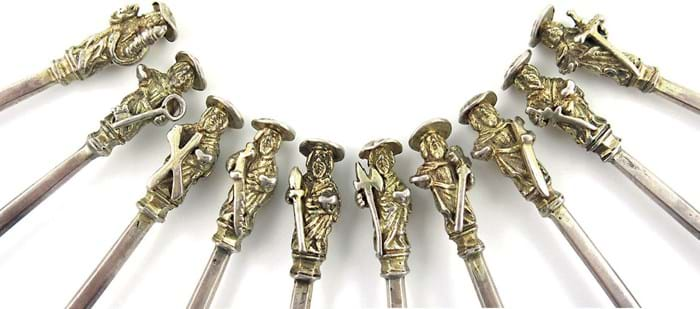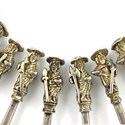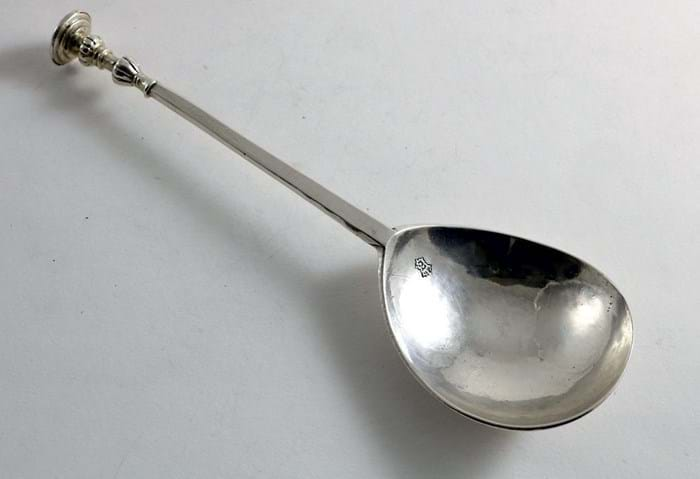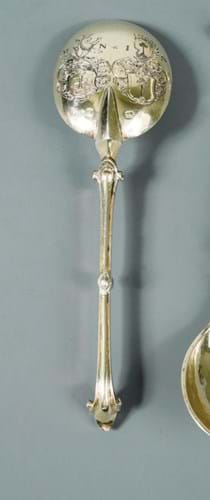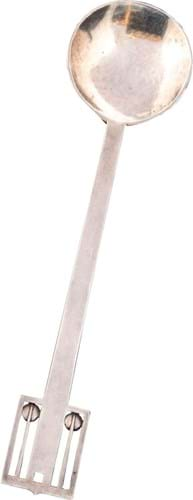They have been produced over the centuries by smiths in obscure villages or in major centres, commissioned as status symbols or simply scratched with newlyweds’ initials and dates – their variety makes them a consuming passion.
Spoons were often very personal items, typically carried when dining as a guest, but they were occasionally made in sets. A full set of apostle spoons, popular in the Tudor and Caroline periods, numbered at least 12. Most have long since been broken up.
Highlight of the Woolley & Wallis (25% buyer’s premium) sale in Salisbury on April 16 was the Mambury set of 10 apostle spoons, made by the prolific and renowned Daniel Cary, London 1607.
“It’s extremely rare to find more than a few spoons from the same set together on the open market,” said silver expert Rupert Slingsby.
The Mambury set – a reference to the possibility it had been owned by the ancient Mambury estate in Devon – originally comprised 14 spoons. It now lacked four, including the scarce finial representing Christ, referred to as The Master, but did include the rarities St Paul with the Long Sword and St Philip with the Short Cross.
Housed in a 1930s custom-made shagreen box, the 10 spoons, each 7in (18cm) long, were estimated at £40,000-50,000 and sold at £48,000. The price was not, in historical terms, huge.
A set of 12 spoons, dated London 1637, which included the Master finial, took a premium-inclusive $216,000 (then about £122,000) at Sotheby’s New York in 2005.
It’s extremely rare to find more than a few spoons from the same set together on the open market
‘The Master’
All bar one of the eight Elizabethan and James I spoon lots from this private collection – all fresh on the market and in fine condition – sold in Salisbury for a total of £92,500.
Best of the single spoons was one dated London 1607, probably by Martin Cotterel, with a gilded finial of The Master with a holy dove nimbus. It doubled expectations to sell at £9500.
Topping the paired offerings were two by William Cawdell, London 1607, with gilded finials of St James The Less and St James the Greater, both with a pierced ‘rays of glory’ nimbus. Estimated at £7000-9000, the two sold at £11,000.
Barnstaple smiths were well represented in the collection including two lots by Thomas Matthew dated c.1580. A pair of lion sejant spoons with gilded finials went on a mid-estimate £7000 while apostle spoons of St Simon Zelotes and James the Less went above hopes at £8000.
An Aphrodite spoon bearing the gilded finial of the Greek goddess is a rarity. The example here by specialist spoon maker John Quick c.1620-30 went well above estimate at £6500.
Made in Norwich
Although at one time the second-richest medieval city in England after London, Norwich closed its assay office in 1702 and relatively little secular silver survives. A prize at the April 9 event at Lawrences (22% buyer’s premium) of Crewkerne was a Charles I ascribed spoon by Arthur Haslewood of Norwich, 1635.
The gilt baluster seal top terminal was pricked AN over PN over 1667. Lawrences specialist Alex Butcher described this rarefied market as ‘fickle’ – sought after by a handful of enthusiasts but potentially one vulnerable to change – so he was delighted when it sold to a collector at £9000 (estimate £4000-5000).
Henry VIII survivor
A Tudor apostle spoon was part of a private collection of English and Continental silver offered for sale by Gildings (18% buyer’s premium) of Market Harborough on March 5.
Although catalogued as 17th century (the marks were rubbed) and estimated at £400-600, it was spotted by many as a much rarer survivor from the reign of Henry VIII.
Marked for the specialist spoon maker William Simpson, 1528, and cast with now much rubbed finial of St Philip, it sold at £6000.
This collection, one which encouraged much of the London silver trade to make the journey to Leicestershire, totalled close to £100,000.
“When a collection of this nature appears on the market in the 21st century, there is still a ripple of excitement throughout the silver world,” said Mark Gilding. “It’s often said silver spoons are a good entry point to market for new collectors. The spread of results here support that, with prices ranging from £120-6000.”
Coated in arms
Best of the silver at Cheffins (22.5% buyer’s premium) in Cambridge on April 11 was a 17th century Continental (possibly Dutch or German) spoon very finely engraved to the reverse of the bowl with the arms of Bernini of Rome and Neidhardt of Austria and Bavaria.
Estimated at £200-300, it sold for £2500 to a Dutch collector.
Hoffmann find
Bringing the subject into the 20th century, a single silver spoon by Josef Hoffmann, founder of the Wiener Werkstätte, emerged for sale at the April 4 sale held by Hansons (20% buyer’s premium) at Bishton Hall, Staffordshire.
“A fantastic find – a very exciting piece,” said Hansons silver specialist Victoria Sheppard of the 6in (15cm) long spoon of unmistakably Viennese design c.1910.
It was stamped WW along with the Vienna 900 standard mark and rose trademark.
“Their work is highly desirable today,” added Sheppard after the spoon, estimated at £800- 1200, sold to an Austrian phone bidder at £3600. “Eight years ago, a Hoffmann teapot sold for €25,000 (£21,372) at Dorotheum in Vienna but this may be a record for a Hoffman spoon.”
- Read ATG’s in-depth guide to silver hallmarks


